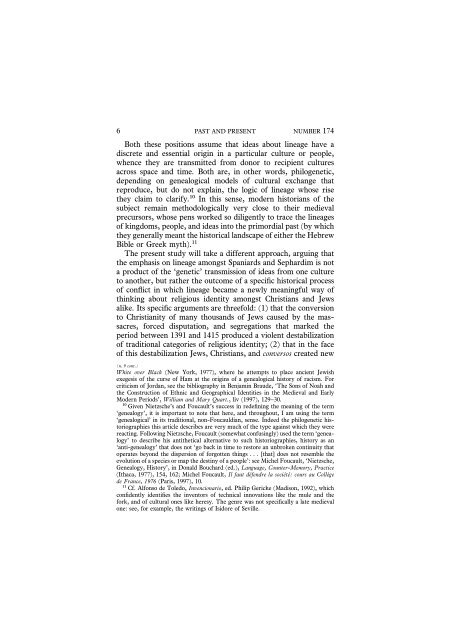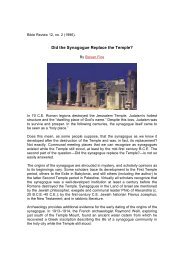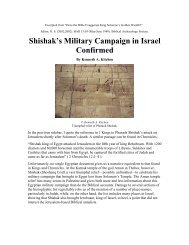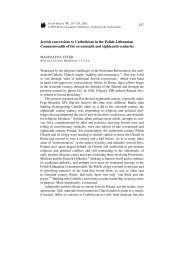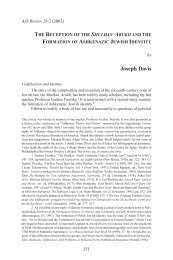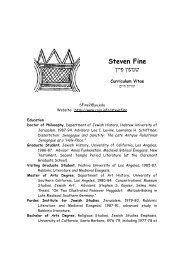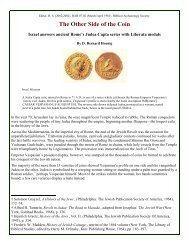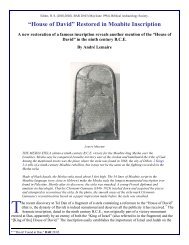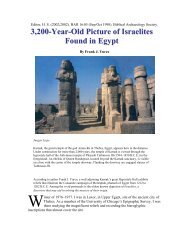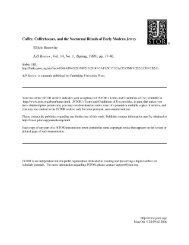jews and christians in fifteenth-century spain
jews and christians in fifteenth-century spain
jews and christians in fifteenth-century spain
You also want an ePaper? Increase the reach of your titles
YUMPU automatically turns print PDFs into web optimized ePapers that Google loves.
6 PAST AND PRESENT NUMBER 174<br />
Both these positions assume that ideas about l<strong>in</strong>eage have a<br />
discrete <strong>and</strong> essential orig<strong>in</strong> <strong>in</strong> a particular culture or people,<br />
whence they are transmitted from donor to recipient cultures<br />
across space <strong>and</strong> time. Both are, <strong>in</strong> other words, philogenetic,<br />
depend<strong>in</strong>g on genealogical models of cultural exchange that<br />
reproduce, but do not expla<strong>in</strong>, the logic of l<strong>in</strong>eage whose rise<br />
they claim to clarify.10 In this sense, modern historians of the<br />
subject rema<strong>in</strong> methodologically very close to their medieval<br />
precursors, whose pens worked so diligently to trace the l<strong>in</strong>eages<br />
of k<strong>in</strong>gdoms, people, <strong>and</strong> ideas <strong>in</strong>to the primordial past (by which<br />
they generally meant the historical l<strong>and</strong>scape of either the Hebrew<br />
Bible or Greek myth).11<br />
The present study will take a different approach, argu<strong>in</strong>g that<br />
the emphasis on l<strong>in</strong>eage amongst Spaniards <strong>and</strong> Sephardim is not<br />
a product of the ‘genetic’ transmission of ideas from one culture<br />
to another, but rather the outcome of a specific historical process<br />
of conflict <strong>in</strong> which l<strong>in</strong>eage became a newly mean<strong>in</strong>gful way of<br />
th<strong>in</strong>k<strong>in</strong>g about religious identity amongst Christians <strong>and</strong> Jews<br />
alike. Its specific arguments are threefold: (1) that the conversion<br />
to Christianity of many thous<strong>and</strong>s of Jews caused by the massacres,<br />
forced disputation, <strong>and</strong> segregations that marked the<br />
period between 1391 <strong>and</strong> 1415 produced a violent destabilization<br />
of traditional categories of religious identity; (2) that <strong>in</strong> the face<br />
of this destabilization Jews, Christians, <strong>and</strong> conversos created new<br />
(n. 9 cont.)<br />
White over Black (New York, 1977), where he attempts to place ancient Jewish<br />
exegesis of the curse of Ham at the orig<strong>in</strong>s of a genealogical history of racism. For<br />
criticism of Jordan, see the bibliography <strong>in</strong> Benjam<strong>in</strong> Braude, ‘The Sons of Noah <strong>and</strong><br />
the Construction of Ethnic <strong>and</strong> Geographical Identities <strong>in</strong> the Medieval <strong>and</strong> Early<br />
Modern Periods’, William <strong>and</strong> Mary Quart., liv (1997), 129–30.<br />
10 Given Nietzsche’s <strong>and</strong> Foucault’s success <strong>in</strong> redef<strong>in</strong><strong>in</strong>g the mean<strong>in</strong>g of the term<br />
‘genealogy’, it is important to note that here, <strong>and</strong> throughout, I am us<strong>in</strong>g the term<br />
‘genealogical’ <strong>in</strong> its traditional, non-Foucauldian, sense. Indeed the philogenetic historiographies<br />
this article describes are very much of the type aga<strong>in</strong>st which they were<br />
react<strong>in</strong>g. Follow<strong>in</strong>g Nietzsche, Foucault (somewhat confus<strong>in</strong>gly) used the term ‘genealogy’<br />
to describe his antithetical alternative to such historiographies, history as an<br />
‘anti-genealogy’ that does not ‘go back <strong>in</strong> time to restore an unbroken cont<strong>in</strong>uity that<br />
operates beyond the dispersion of forgotten th<strong>in</strong>gs . . . [that] does not resemble the<br />
evolution of a species or map the dest<strong>in</strong>y of a people’: see Michel Foucault, ‘Nietzsche,<br />
Genealogy, History’, <strong>in</strong> Donald Bouchard (ed.), Language, Counter-Memory, Practice<br />
(Ithaca, 1977), 154, 162; Michel Foucault, Il faut défendre la société: cours au Collège<br />
de France, 1976 (Paris, 1997), 10.<br />
11 Cf. Alfonso de Toledo, Invencionario, ed. Philip Gericke (Madison, 1992), which<br />
confidently identifies the <strong>in</strong>ventors of technical <strong>in</strong>novations like the mule <strong>and</strong> the<br />
fork, <strong>and</strong> of cultural ones like heresy. The genre was not specifically a late medieval<br />
one: see, for example, the writ<strong>in</strong>gs of Isidore of Seville.


